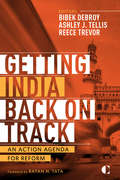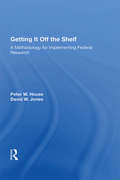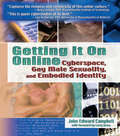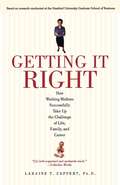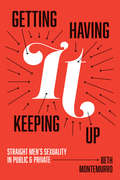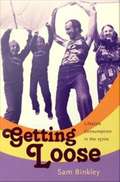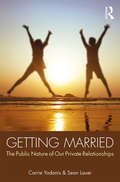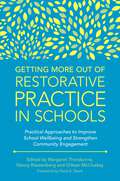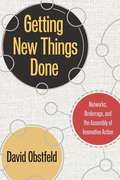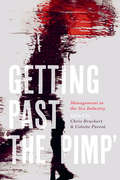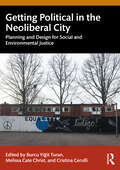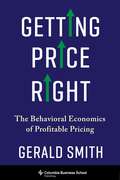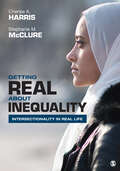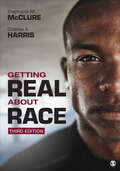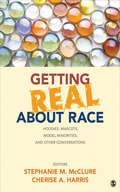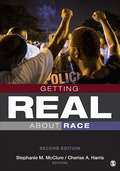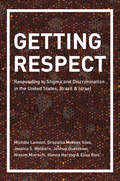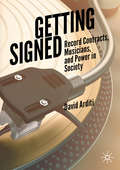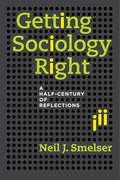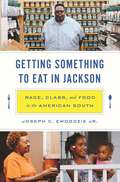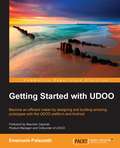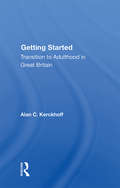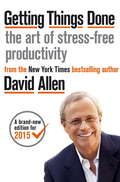- Table View
- List View
Getting India Back on Track
by Ashley J. Tellis Reece Trevor Bibek DebroyIndia has fallen far and fast from the runaway growth rates it enjoyed in the first decade of the twenty-first century. In order to reverse this trend, New Delhi must seriously reflect on its policy choices across a wide range of issue areas. Getting India Back on Track broadly coincides with the 2014 Indian elections to spur a public debate about the program that the next government should pursue in order to return the country to a path of high growth. It convenes some of India's most accomplished analysts to recommend policies in every major sector of the Indian economy. Taken together, these seventeen focused and concise memoranda offer policymakers and the general public alike a clear blueprint for India's future.ContentsForewordRatan N. Tata (Chairman, Tata Trusts)IntroductionAshley J. Tellis and Reece Trevor (Carnegie Endowment for International Peace)1. Maintaining Macroeconomic StabilityIla Patnaik (National Institute of Public Finance and Policy)2. Dismantling the Welfare StateSurjit Bhalla (Oxus Investments)3. Revamping Agriculture and the Public Distribution SystemAshok Gulati (Commission for Agriculture Costs and Prices)4. Revisiting Manufacturing PolicyRajiv Kumar (Centre for Policy Research)5. Generating EmploymentOmkar Goswami (Corporate and Economic Research Group)6. Expanding Education and SkillsLaveesh Bhandari (Indicus Analytics)7. Confronting Health ChallengesA. K. Shiva Kumar (National Advisory Council)8. Accelerating Infrastructure ModernizationRajiv Lall and Ritu Anand (IDFC Limited)9. Managing UrbanizationSomik Lall and Tara Vishwanath (World Bank)10. Renovating Land ManagementBarun S. Mitra (Liberty Institute) and Madhumita D. Mitra (consultant)11. Addressing Water ManagementTushaar Shah (International Water Management Institute) and Shilp Verma (independent researcher)12. Reforming Energy Policy and PricingSunjoy Joshi (Observer Research Foundation)13. Managing the EnvironmentLigia Noronha (Energy and Resources Institute)14. Strengthening Rule of LawDevesh Kapur (University of Pennsylvania) and Milan Vaishnav (Carnegie Endowment for International Peace)15. Correcting the Administrative DeficitBibek Debroy (Centre for Policy Research)16. Building Advanced Technology Capacity for Competitive Arms AcquisitionRavinder Pal Singh (Stockholm International Peace Research Institute)17. Rejuvenating Foreign PolicyC. Raja Mohan (Observer Research Foundation and Carnegie Endowment for International Peace
Getting It Off The Shelf: A Methodology For Implementing Federal Research
by Ernest R HouseIn 1976, the federal government spent over $10 billion on civilian research, development, and demonstration projects. The vast majority of these dollars were spent for applied research-research from which it is reasonable to expect a payoff in implementation, commercialization, or problem solving. In all too many cases, that payoff has not been for
Getting It On Online: Cyberspace, Gay Male Sexuality, and Embodied Identity
by John Edward CampbellLearn how gay men use Internet technologies to connect with others sharing their erotic desires and to forge affirming communities online! Getting It On Online: Cyberspace, Gay Male Sexuality, and Embodied Identity examines the online embodied experiences of gay men. At once scholarly and sensual, this unique book is the result of a three-year ethnographic study chronicling the activities on three distinct social scenes in the world of Internet Relay Chat (IRC)-virtual spaces constructed by gay men for the erotic exploration of the male body. Examining the vital role the body plays in defining these online spaces offers insight into how gay men negotiate their identities through emerging communication technologies. The author combines a critical look at the role of the body in cyberspace with candid accounts of his own online experiences to challenge conventional views on sex, sexuality, and embodied identity. Getting It On Online provides an inside look at three specific online communities-gaychub (a community celebrating male obesity), gaymuscle (a community formulated around images of the muscular male body), and gaymusclebears (a space representing the erotic convergence of the obese and muscular male bodies emerging out of the gay male "bear" subculture)-in an effort to unsettle those models of beauty and the erotic depicted in more mainstream media. The book demonstrates how the social position of these men in the physical world in regards to age, race, gender, class, and physical beauty influences their online experiences. Far from a realm of bodiless exultation, Getting It On Online illustrates how the flesh remains very much present in cyberspace. Getting It On Online examines topics such as: why people chat online the history of IRC (Internet Relay Chat) how people construct their identities in cyberspace how some online spaces function like virtual gay bars the concept of online disembodiment the role the body plays in online social relations the future of online communication ethnographic research in cyberspace mediated images of the male body and the gay male beauty myth and much more! Getting It On Online: Cyberspace, Gay Male Sexuality, and Embodied Identity is an essential resource for anthropologists, sociologists, and psychologists; academics working in gender studies, queer theory, cultural studies, and cyber-culture studies; and anyone interested in gay and lesbian issues and/or cyberspace.
Getting It Right
by ZappertCareer or motherhood? Do you have to sacrifice one to be truly successful in the other? And if you're trying to do both, will you have to compromise your career path or your child's needs? With professional demands increasingly impinging on personal time, is "having it all" even realistic, or is it just plain fantasy? Now leading Stanford University psychologist Dr. Laraine Zappert, who specializes in the issues of women and work, draws upon her twenty years of clinical and research experience and a landmark study to answer these questions and create a road map of innovative solutions. Dr. Zappert surveyed more than three hundred women who have graduated from Stanford's Graduate School of Business, and has incorporated case studies from hundreds of women professionals in each chapter. Her findings address such common concerns as: Do I really have to choose between career and family? How do I handle the stresses of my job and the demands of parenting? How do children affect my career, and when is the best time to have them? How do I keep my relationships healthy? Who will care for my children when I'm not available? Coming from many different occupational backgrounds, the subjects of Dr. Zappert's study show us that although we so often think that everyone else is doing it better and having an easier time of it, that is hardly ever the case. Sometimes "good enough" has to do. And whereas the stresses may be the same for all working women, the solutions rarely are. Let the insights, advice, and strategies found in Getting It Right help you make smarter, more informed decisions for creating a satisfying and fulfilling lifestyle on every level.
Getting It, Having It, Keeping It Up: Straight Men’s Sexuality in Public and Private
by Beth MontemurroScholars and social critics are looking at gender and sexuality, as well as masculinity, in new ways and with more attention to the way cultural ideologies affect men’s and women’s lives. With the rise of an online “incel” (involuntarily celibate) community and the perpetration of acts of violence in their name, as well as increased awareness about the complexities of sexual interaction brought to the fore by the #metoo movement, it has become critical to discuss how men’s sexuality and masculinity are related, as well as the way men feel about the messages they get about being a man. Prior research on masculinity and masculine sexuality has examined the experiences of adolescent boys. But what happens to boys as they become men and as many move away from homo-social environments into sexual relationships? What happens when they no longer have a crowd of peers to posture or perform for? How do their sexual experiences and sexual selves change? How do they prove their masculinity in a society that demands it when they are no longer surrounded by peers? And how do they cultivate sexual selves and sexual self-confidence in a culture that expects them to always already be knowledgeable, desiring sexual subjects? In Getting It, Having It, Keeping It Up, Beth Montemurro explores the cultivation of heterosexual men’s sexual selves. Based on detailed, in-depth interviews with a large, diverse group of heterosexual men between the ages of 20 and 68, she investigates how getting sex, having sex, and keeping up their sex lives matters to men. Ultimately, Montemurro uncovers the tension between public, cultural narratives about hetero-masculinity and men’s private, sexual selves and their intimate experiences.
Getting Loose: Lifestyle Consumption in the 1970s
by Sam BinkleyFrom "getting loose" to "letting it all hang out," the 1970s were filled with exhortations to free oneself from artificial restraints and to discover oneself in a more authentic and creative life. In the wake of the counterculture of the 1960s, anything that could be made to yield to a more impulsive vitality was reinvented in a looser way. Food became purer, clothing more revealing, sex more orgiastic, and home decor more rustic and authentic. Through a sociological analysis of the countercultural print culture of the 1970s, Sam Binkley investigates the dissemination of these self-loosening narratives and their widespread appeal to America's middle class. He describes the rise of a genre of lifestyle publishing that emerged from a network of small offbeat presses, mostly located on the West Coast. Amateurish and rough in production quality, these popular books and magazines blended Eastern mysticism, Freudian psychology, environmental ecology, and romantic American pastoralism as they offered "expert" advice--about how to be more in touch with the natural world, how to release oneself into trusting relationships with others, and how to delve deeper into the body's rhythms and natural sensuality. Binkley examines dozens of these publications, including the Whole Earth Catalog, Rainbook, the Catalog of Sexual Consciousness, Celery Wine, Domebook, and Getting Clear. Drawing on the thought of Pierre Bourdieu, Zygmunt Bauman, and others, Binkley explains how self-loosening narratives helped the middle class confront the modernity of the 1970s. As rapid social change and political upheaval eroded middle-class cultural authority, the looser life provided opportunities for self-reinvention through everyday lifestyle choice. He traces this ethos of self-realization through the "yuppie" 1980s to the 1990s and today, demonstrating that what originated as an emancipatory call to loosen up soon evolved into a culture of highly commercialized consumption and lifestyle branding.
Getting Married: The Public Nature of Our Private Relationships (Sociology Re-Wired)
by Carrie Yodanis Sean LauerIn Getting Married, Carrie Yodanis and Sean Lauer examine the social rules and expectations that shape our most personal relationships. How do couples get together? How do people act when they’re married? What happens when they’re not? Public factors influence our private relationships. From getting engaged to breaking up, social rules and expectations shape and constrain whom we select as a spouse, when and why we decide to get married, and how we arrange our relationships day to day. While this book is about marriage, it is also about sociology. Yodanis and Lauer use the case of marriage to explore a sociological perspective. Getting Married will bring together students’ academic and social worlds by applying sociology to the things they are thinking about and experiencing outside of the classroom. This book is a useful tool for many sociology courses, including those on family, gender, and introduction to sociology.
Getting More Out of Restorative Practice in Schools: Practical Approaches to Improve School Wellbeing and Strengthen Community Engagement
by Michael Friedman Margaret Thorsborne Nancy Riestenberg Jim McGrath Beverley Turner Gillean McCluskey Fania Davis Sue Attrill Carole Edgerton Lyndsay Broadfoot Samia Farooq Sharon Fitzpatrick Kerri Berkowitz Cindy Zwicky David Yusem Terence Bevington Katie Cebula Annie O’Shaughnessy Denise Quinlan Anna Gregory Nathan Wallis Sara Davis Julia Hennessy Nici NixonRestorative practice (RP) has been successfully implemented in schools for decades and is primarily associated with improving behaviour and relationships, by changing the culture of problem solving in the school. However, it has huge untapped potential to support initiatives in other areas, and this book provides examples of how RP can enhance the effectiveness of these other practices.Split into three sections, the book first looks at implementation, readiness and evaluation. It then covers integrating RP with, and linking RP into, other issues relevant to schools such as trauma, poverty, and mindfulness, and finally shows how to work well with parents and families. The book gives proven strategies for measuring success and evaluating effectiveness. Overall, it provides insight into a variety of issues RP can help schools with, and addresses them in practical ways to help schools implement restorative practice to its full potential.
Getting New Things Done: Networks, Brokerage, and the Assembly of Innovative Action
by David ObstfeldOur networks—and how we work them—create vital ties that bind. Organizations recognize and reward this fact by leaning ever more heavily on collaboration, particularly when it comes to getting new things done. This book offers a framework that explains how innovators use network processes to broker knowledge and mobilize action. How well they do so directly influences the outcome of attempts to innovate, especially when a project is not tied to proscribed organizational routines. An entrepreneur launches a business. A company rolls out a new product line. Two firms form a partnership. These instances and many more like them dot today's business landscape. And yet, we understand little about the social dimension of these undertakings. Disentangling brokerage from network structure and building on his theoretical work regarding tertius iungens, David Obstfeld explains how actors with diverse interests, expertise, and skills leverage their personal and intellectual connections to create new ventures and products with extraordinary results.
Getting Past "the Pimp": Management in the Sex Industry
by Chris Bruckert Colette ParentThe issue of third parties in the sex industry – individuals who are neither the client nor the service provider – has become especially urgent in our current socio-political context. Surprisingly, in spite of an emergence of critical scholarship on the sex industry, as well as recommendations by key governmental committees, little attention has been extended to examining the role of individuals labelled pimps, procurers, and traffickers. Addressing the function of third parties on the street and indoors, Getting Past "the Pimp" incorporates solid empirical evidence including documentary analysis, 75 interviews with third parties, and 52 interviews with sex workers to unpack the roles and relationships of third parties in three sectors of the sex industry‒ incall/outcall, stripping, and street-based prostitution. Contrary to prevailing stereotypes that portray third parties as inherently abusive and controlling, these workers fulfill important roles and provide vital services as associates, fee-for-service hires, and agency owners or managers responsible for scheduling and arranging transportation and security. The sex industry, like mainstream businesses, rarely depend exclusively on client and worker to operate efficiently, and safely.
Getting Political in the Neoliberal City: Planning and Design for Social and Environmental Justice
by Cristina Cerulli Burcu Yiğit Turan Melissa Cate ChristIn a world defined by ever-deepening crises—climate, social, economic, and political—urban spaces emerge as both battlegrounds of injustice and the arenas of possibility. Getting Political in the Neoliberal City interrogates the roles of planners, architects, designers, and urban citizens in challenging the pervasive inequities of neoliberal urbanism. Drawing from critical case studies spanning continents and disciplines, this volume reframes the intersections of spatial and social justice to illuminate how space becomes a site of power, exclusion, and potential resistance.Through incisive essays and reflective scholarship, this book explores how cities are shaped by market forces and neoliberal governance, yet also serve as sites for insurgent practices at various scale, grassroots movements, and alternative imaginaries that resist dominant modes of urbanization and claim just ways of making cities. Highlighting the emergencess of new epistemologies, subjectivities and critical agencies, Getting Political in the Neoliberal City calls for a transformative rethinking of urban and environmental planning, design, and citizenship.Featuring contributions from scholars and practitioners in diverse fields, including architecture, geography, political science, and anthropology, the book maps the tensions between depoliticized scholarly and professional practices and the urgent need for politicized action. With compelling examples from Australia, Brazil, Cyprus, Denmark, Germany, Hong Kong, the USA, and Sweden, this book offers fresh insights into ongoing research on the struggles for more equitable, inclusive, and environmentally just cities. It also provides opportunities to understand the historical contextuality of each case and to reflect on the nuances, similarities, and global connections between different cases across different geographies.
Getting Price Right: The Behavioral Economics of Profitable Pricing
by Dr. Gerald SmithHow do leaders, managers, and proprietors go about the essential task of setting prices? What biases enter into this process, and why? How can a business debias its price setting to become more productive, strategic, and profitable?Combining perceptive insights from behavioral economics with leading-edge ideas on price management, this book offers a new approach to pricing. Gerald Smith demonstrates why understanding, reframing, and refining everyday pricing processes—a firm’s or manager’s pricing orientation—results in a better long-term pricing strategy. He explores how pricing actually happens in practice and shows how to identify and remove the psychological blinders that cause suboptimal decisions and policies. Smith details how to improve pricing orientation by combining the soft behavioral skills that intuitively shape and refine pricing practice with the hard analytic skills that guide and structure pricing strategy. The result is more rational and more profitable pricing—with respect to not only revenue and profitability but also employee productivity and customer satisfaction.Offering an accessible and actionable model, Getting Price Right is the first book to apply behavioral economics to managerial price setting. It is a must-read for corporate business leaders, thought leaders, and professionals interested in advances in pricing and for managers, entrepreneurs, proprietors, and small and midsize business owners whose everyday work involves pricing.
Getting Real About Inequality: Intersectionality in Real Life
by Cherise A. Harris Stephanie M. McClureGetting Real About Inequality is a contributed reader for undergraduate courses in Race/Class/Gender, Social Inequality, or the Social Construction of Difference and Inequality. It gives instructors in these courses a set of materials to help them moderate civil, productive, and social science-based discussions with their students about social statuses and identities. Like the book it is modeled after, Getting Real About Race, it is organized around myths and stereotypes that students might already believe or be familiar with through the media or popular culture. A panel of expert contributors were enlisted to write short, accessible essays address the same questions (What is the myth or stereotype under investigation? How do we know that the myth or stereotype is widespread? What does the empirical data tell us?) and provide the same pedagogical features (a summary of the research data, discussion questions, suggestions for further study, suggested activities and assignments). All of pieces in the book employ an intersectional perspective, to help students see the nuanced mechanisms of power and inequality that are often lost in everyday discourse.
Getting Real About Race
by Cherise A. Harris Stephanie M. McClureGetting Real About Race is an edited collection of short essays that address the most common stereotypes and misconceptions about race held by students, and by many in the United States, in general. Key Features Each essay concludes with suggested sources including videos, websites, books, and/or articles that instructors can choose to assign as additional readings on a topic. Essays also end with questions for discussion that allow students to move from the "what" (knowledge) to the "so what" (implications) of race in their own lives. In this spirit, the authors include suggested "Reaching Across the Color Line" activities at the end of each essay, allowing students to apply their new knowledge on the topic in a unique or creative way. Current topics students want to discuss are brought up through the text, making it easier for the instructor to deal with these topics in an open classroom environment.
Getting Real About Race
by Cherise A. Harris Stephanie M. McClureGetting Real About Race is an edited collection of short essays that address the most common stereotypes and misconceptions about race held by students, and by many in the United States, in general. Key Features Each essay concludes with suggested sources including videos, websites, books, and/or articles that instructors can choose to assign as additional readings on a topic. Essays also end with questions for discussion that allow students to move from the "what" (knowledge) to the "so what" (implications) of race in their own lives. In this spirit, the authors include suggested "Reaching Across the Color Line" activities at the end of each essay, allowing students to apply their new knowledge on the topic in a unique or creative way. Current topics students want to discuss are brought up through the text, making it easier for the instructor to deal with these topics in an open classroom environment.
Getting Real About Race: Hoodies, Mascots, Model Minorities, and Other Conversations
by Stephanie M. Mcclure Cherise A. HarrisStephanie McClure and Cherise A. Harris’s Second Thoughts on Race in the United States: Hoodies, Model Minorities, and Real Americans is an edited collection of short essays that address the most common misconceptions about race held by students (and by many in the United States, in general)—it is a "one-stop shopping" reader on the racial topics most often pondered by students and derived from their interests and concerns. There is no existing reader that summarizes the research across a range of topics in a consistent, easily accessible format and considers the evidence against particular racial myths in the language that students themselves use.
Getting Real About Race: Hoodies, Mascots, Model Minorities, and Other Conversations
by Cherise A. Harris Stephanie M. McClureGetting Real About Race is an edited collection of short essays that address the most common stereotypes and misconceptions about race held by students, and by many in the United States, in general.
Getting Real About Race: Hoodies, Mascots, Model Minorities, and Other Conversations
by Stephanie M. Mcclure Cherise A. HarrisGetting Real About Race is an edited collection of short essays that address the most common stereotypes and misconceptions about race held by students, and by many in the United States, in general.
Getting Respect: Responding to Stigma and Discrimination in the United States, Brazil, and Israel
by Michèle Lamont Hanna Herzog Joshua Guetzkow Graziella Moraes Silva Elisa Reis Jessica Welburn Nissim MizrachiRacism is a common occurrence for members of marginalized groups around the world. Getting Respect illuminates their experiences by comparing three countries with enduring group boundaries: the United States, Brazil and Israel. The authors delve into what kinds of stigmatizing or discriminatory incidents individuals encounter in each country, how they respond to these occurrences, and what they view as the best strategy--whether individually, collectively, through confrontation, or through self-improvement--for dealing with such events.This deeply collaborative and integrated study draws on more than four hundred in-depth interviews with middle- and working-class men and women residing in and around multiethnic cities--New York City, Rio de Janeiro, and Tel Aviv--to compare the discriminatory experiences of African Americans, black Brazilians, and Arab Palestinian citizens of Israel, as well as Israeli Ethiopian Jews and Mizrahi (Sephardic) Jews. Detailed analysis reveals significant differences in group behavior: Arab Palestinians frequently remain silent due to resignation and cynicism while black Brazilians see more stigmatization by class than by race, and African Americans confront situations with less hesitation than do Ethiopian Jews and Mizrahim, who tend to downplay their exclusion. The authors account for these patterns by considering the extent to which each group is actually a group, the sociohistorical context of intergroup conflict, and the national ideologies and other cultural repertoires that group members rely on.Getting Respect is a rich and daring book that opens many new perspectives into, and sets a new global agenda for, the comparative analysis of race and ethnicity.
Getting Signed: Record Contracts, Musicians, and Power in Society
by David ArditiRecord contracts have been the goal of aspiring musicians, but are they still important in the era of SoundCloud? Musicians in the United States still seem to think so, flocking to auditions for The Voice and Idol brands or paying to perform at record label showcases in the hopes of landing a deal. The belief that signing a record contract will almost infallibly lead to some measure of success— the “ideology of getting signed,” as Arditi defines it—is alive and well. Though streaming, social media, and viral content have turned the recording industry upside down in one sense, the record contract and its mythos still persist. Getting Signed provides a critical analysis of musicians’ contract aspirations as a cultural phenomenon that reproduces modes of power and economic exploitation, no matter how radical the route to contract. Working at the intersection of Marxist sociology, cultural sociology, critical theory, and media studies, Arditi unfolds how the ideology of getting signed penetrated an industry, created a mythos of guaranteed success, and persists in an era when power is being redefined in the light of digital technologies.
Getting Sociology Right
by Neil J. SmelserNeil J. Smelser, one of the most important and influential American sociologists, traces the discipline of sociology from 1969 to the early twenty-first century in Getting Sociology Right: A Half-Century of Reflections. Examining sociology as a vocation and building on the work of Talcott Parsons, Smelser discusses his views on the discipline of sociology and shows how his perspective of the field evolved in the postwar era.
Getting Something to Eat in Jackson: Race, Class, and Food in the American South
by Joseph C. Ewoodzie Jr.A vivid portrait of African American life in today’s urban South that uses food to explore the complex interactions of race and classGetting Something to Eat in Jackson uses food—what people eat and how—to explore the interaction of race and class in the lives of African Americans in the contemporary urban South. Joseph Ewoodzie Jr. examines how “foodways”—food availability, choice, and consumption—vary greatly between classes of African Americans in Jackson, Mississippi, and how this reflects and shapes their very different experiences of a shared racial identity.Ewoodzie spent more than a year following a group of socioeconomically diverse African Americans—from upper-middle-class patrons of the city’s fine-dining restaurants to men experiencing homelessness who must organize their days around the schedules of soup kitchens. Ewoodzie goes food shopping, cooks, and eats with a young mother living in poverty and a grandmother working two jobs. He works in a Black-owned BBQ restaurant, and he meets a man who decides to become a vegan for health reasons but who must drive across town to get tofu and quinoa. Ewoodzie also learns about how soul food is changing and why it is no longer a staple survival food. Throughout, he shows how food choices influence, and are influenced by, the racial and class identities of Black Jacksonians.By tracing these contemporary African American foodways, Getting Something to Eat in Jackson offers new insights into the lives of Black Southerners and helps challenge the persistent homogenization of blackness in American life.
Getting Started with UDOO
by Emanuele PalazzettiIf you are an Android developer who wants to learn how to use UDOO to build Android applications that are capable of interacting with their surrounding environment, then this book is ideal for you. Learning UDOO is the next great step to start building your first real-world prototypes powered by the Android operating system.
Getting Started: Transition To Adulthood In Great Britain
by Alan C. KerckhoffThis book provides evidence of the significance of a society's structure and normative definitions in giving shape to one part of the life course, examining closely a major period of life course transition, the move from adolescence to adulthood in Great Britain.
Getting Things Done: The Art of Stress-free Productivity
by David Allen'The Bible of business and personal productivity' Lifehack'A completely revised and updated edition of the blockbuster bestseller from 'the personal productivity guru' Fast CompanySince it was first published almost fifteen years ago, David Allen's Getting Things Done has become one of the most influential business books of its era, and the ultimate book on personal organization. 'GTD' is now shorthand for an entire way of approaching professional and personal tasks, and has spawned an entire culture of websites, organizational tools, seminars, and offshoots.Allen has rewritten the book from start to finish, tweaking his classic text with important perspectives on the new workplace, and adding material that will make the book fresh and relevant for years to come. This new edition of Getting Things Done will be welcomed not only by its hundreds of thousands of existing fans but also by a whole new generation eager to adopt its proven principles.
